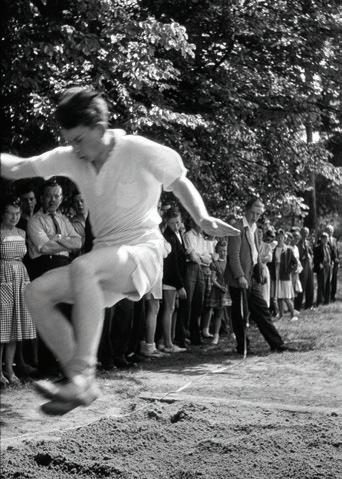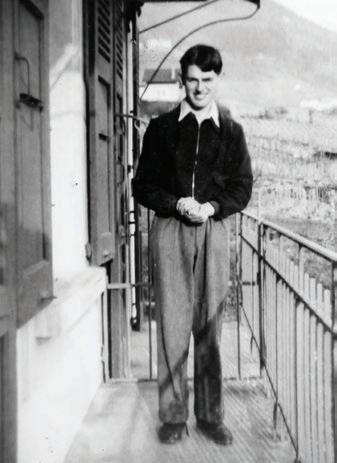
7 minute read
In the Archives
IN THE
ARCHIVES
Capturing Caterham
By OC Geoff Noxon
The currency of the captured image is at an all-time high with camera-containing digital devices in most folks’ pockets. Of course, it has not always been thus, which makes Geoff Noxon’s collection of school images from the years 1955-1962, a rare treat.
Geoff was kind enough to share his photos with us and reflected on how his interest, and later his career path, began at Caterham: “Dating back to my Caterham days I have had a life-long interest in photography and worked in Ilford’s research and development all my working life, first in Essex then in Cheshire. My early Caterham photos were shot on black and white positive film.”
Geoff’s talent and passion for the captured image has endured throughout his career and retirement: “I did much work on the colour couplers for Ilford’s XP2 chromogenic monochrome film. I went to King’s College London, a venue which afforded me a grandstand view of Churchill’s funeral, my photos of which were subsequently published in London University’s newspaper.”
“When I retired I did some photography of Listed Buildings in my area for English Heritage (visit here: imagesofengland.org.uk) using film supplied by them and Nikon shift lenses, in order to keep things upright as later correction was not possible.”



Geoff’s sports photos show life in full flow on Caterham’s sports fields. Says Geoff: “My film and lens were both slow, it was my first 35mm camera. Unfortunately, I have no record of those depicted but I can tell you that the long jump used to be located adjacent to the road and at the bottom of a field leading up to Beech Hanger.
Further up the road leading to Viewpoint was a vantage point from which to view cricket on the Home Field. However, when I visited an Old Boys’ Day cricket match, my car (parked among others) on that road stopped a ball hit for six (typical of my luck)!”



Caterham was very much a family affair for the Noxons. Geoff reminisced: “My grandparents were posted to Cairo between WW1 and WW2” so sent their boys: F.R Noxon (my father) and his younger brother E.H Noxon to Caterham School. I (R.G. Noxon) and my only male cousin (C.F. Noxon) followed, then my eldest cousin sent her two boys (A.M. & A.C Jacobs) making a family total of six.”
Geoff’s photo of the WW2 memorial (which is located in the Leathem Foyer overlooking the Home Field) clearly shows his father’s name F.R. Noxon following his passing which is marked with a war grave in Chennai, India.

“In case my photo of the steps is no longer recognised: at the base of those steps the school buildings are to the left and the old swimming baths to the right (now the location of the Eothen Building which replaced the baths in 1995). At the top the Memorial Hall (now the Maggs Library) is to the left and the Sanatorium (now Hillside) is to the right. My late uncle E.H Noxon DFC, who was a pupil in the early 1930s, told me that in his day there was a choice of cold clean water at the start of term or warm but soup-like water at the end of term! I cannot vouch for the veracity of this or his other remark: the central cold water brass taps, over each communal wash basin, was all they had as the offset chrome hot taps had been added later!”
“The story behind that odd black and white positive film is that it was given to me by my maternal uncle who had forgotten that he had started to use it on Regents Street Christmas decorations and then wound it back to the start! This was a double exposure but I thought it worth salvaging as it was a very long exposure along the School’s main corridor, towards the Headmaster’s house. Because it was an exposure of several minutes, people walking along the corridor failed to register!”

IN THE
ARCHIVES
A Mountainous Adventure
In the current era of day trips to France and Belgium and with pupils choosing from numerous expeditions both to Europe, the USA, Asia and beyond, it is perhaps hard to comprehend what the first post-war overseas trip meant to pupils, teachers and parents.
Less than a decade after Caterhamians’ celebrated the end of World War 2, with many OCs having been engaged with the allied forces in Europe and across the globe, forwardlooking and intrepid mood prevailed in the Harestone Valley. Plans to revive educational trips to Europe began again. The School had taken many such trips prior to the Second World War and in 1952, under expert eyes of Mr Hayward and Mr Price, planning begun once again.
OCs Martin Stevens (OC 1945-1954) and John Overy Holroyd-Doverton (OC 1945-1952) got in contact to share their memories and photographs of this first post-war trip to the towns and peaks of Switzerland.
Martin Stevens recollects setting off for this grand adventure: “On April 2, 1952 our party gathered at Victoria Station for the boat train to Dover, where we boarded our ferry to Ostend. There followed a long overnight journey to Basle. I wearily recorded in my diary, “In Basel express till 5.15am. No sleep. Breakfast at Basel Station.” (There was no thought of air travel in those days).”
There were some sacrifices to be made by boys wishing to take part in the trip, as John Overy HolroydDoveton recalls: “I sold my trainset to pay for it. We travelled by train to Basel. I remember being woken at the frontier of Luxembourg, a warning to those who live in nostalgia for a pre EC Europe. Although we were lucky to have padded seats, we had no such luck returning. All we had was wooden seats.”


Memories from OCs Martin Stevens and John Overy Holroyd-Doveton
John Overy Holroyd-Doveton John Wright



L–R: R. Caston (Pog), J. Roberts-Lewis, Martin Stevens (Else), I. Cubison, P.A. Hilton (Tovey), R. Hamberg (Saus)

L–R: ?, M.H. Osborn, G.R. Berwick (Gerry)
The view afforded from the window in the latter part of the boys’ journey made an impression for Martin Stevens who recollected: “There followed a further rail journey to Montreux through the staggeringly magnificent Swiss mountains to our hotel, the Hotel Montbrillant. Accommodation varied: four of us shared one room, and spent a lot of time together.”
“Some memories have faded, but the scenery of the Alps remains unforgotten: Rochers de Naye behind Montreux (6000’ and cold); the amazingly clear day at Champery with the Dents du Midi seen from the rack and pinion railway, dazzling bright in unbroken sunshine, a day seized on opportunely by Mr Price when he saw a bright clear morning. There were also trips to Lausanne, and to Gruyere with the famous cheese factory – which disappointingly we were not allowed to enter. There was also boating on Lake Geneva (Lac Leman), and sightseeing in Berne on our way home.”
Martin and his contemporaries’ reflections on this first post-war trip clearly show happy memories of this ambitious endeavour by the School. The contrast to the trip provision enjoyed by current day Caterhamians in this era of a regularly criss-crossed globe is noted:
“Other memories include practising our French, instilled into us previously by Mr Hayward and Mr Ward (Laddie Ward), with some Swiss differences, e.g. ‘quatrevingt-dix’ became ‘neufante’. The exchange rate of the Pound with the Swiss Franc stretched us, especially too when we purchased gifts for those at home; the effect of the war was still felt here. But the way had been set for future excursions: the range of travel recorded in today’s Omnia would have staggered us.“ “Our journey home was overnight – “On Ostend express till 8.00am” I wrote. But a good crossing revived our spirits, with a hearty breakfast of bacon and eggs – not thoughts of seasickness! And so to Victoria and parting for our various routes home.”
And so an English Breakfast was the cheerful conclusion for this first post war trip which set a happy and much followed precedent for School trips thereafter. Thank you to our OCs for sharing memories of this landmark trip in the school’s history.










